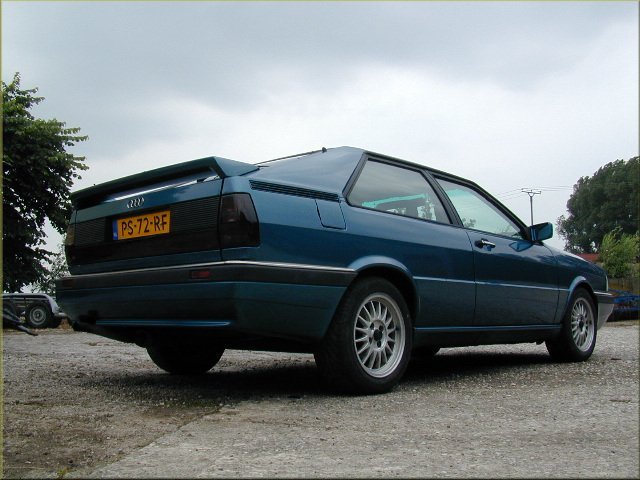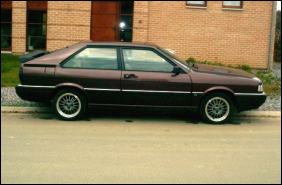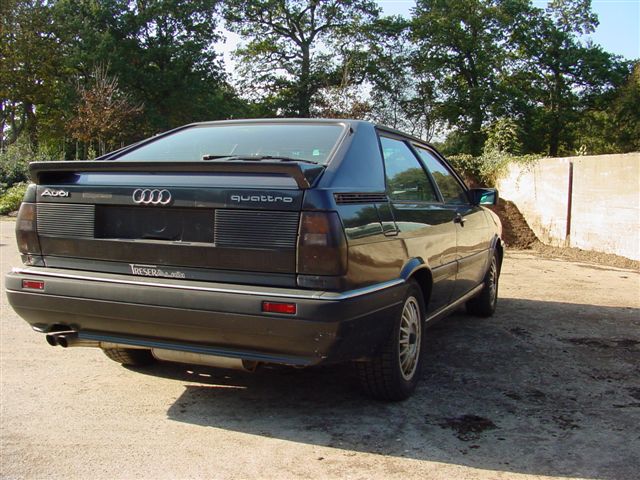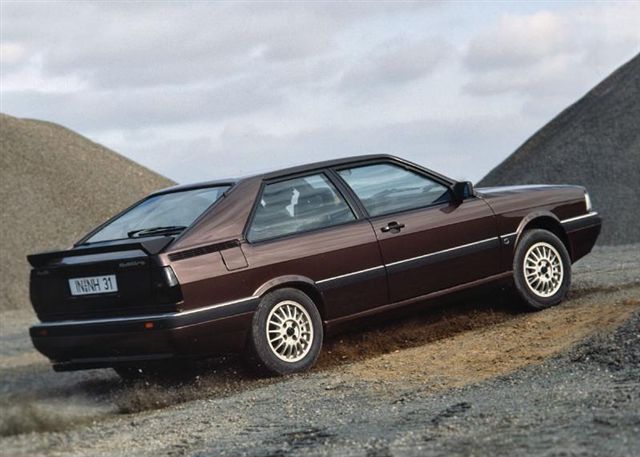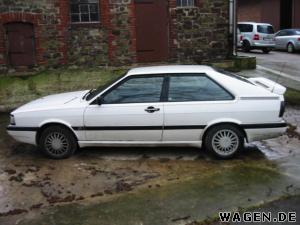The Coupe quattro
My CQ
Ongoing Restoration
Gallery
Info / Data
Suppliers
Links
T85q.com
Type 85 Differential Locks, A User's Guide
Application
The following remarks apply specifically to the vacuum-operated differential locks found on the 1984 - 88 Audi Coupe quattro, 1984 - 86 Audi 90 quattro and 1984 - 87 Audi Ur-quattro. Other quattro models are similar in principle but differ in detail.
General Principles
A differential is a device positioned between wheels on the same axle, or on the Audi quattro between axles as well, which allows the wheels or axles to turn at different speeds. Allowing the wheels to turn at different speeds is necessary as the arc described (and distance travelled) by the left and right wheel on the same axle (and wheels on different axles) is different when turning a corner.
Therefore, it is necessary that the wheels are allowed to turn at different speeds; otherwise the wheels will scrub against the road surface causing excessive tyre wear, drivetrain damage through "wind-up" induced stresses, and somewhat interesting handling characteristics. The downside of this situation is that the usual "open" differential, when one wheel is on a low-friction surface and the torque applied exceeds the adhesion of the tyre, will spin away all that torque, the other wheel(s) will get none and the car will go nowhere. (There are "limited-slip" differentials that allow a certain amount of slip for corners but still transmit a certain amount of torque between wheels, but these are not fitted to the Type 85 Coupe quattro or 90 quattro). Locking a differential can give better traction on slippery surfaces as the vehicle can still move forward even if only one wheel has grip.
The Audi quattro
The Audi quattro system was fitted with driver-operated differential locks in varying configurations from its inception in 1980 until the mid-1990s when they were replaced with more sophisticated electronic devices. Very early cars from 1980 were fitted with cable-operated locks, which were soon replaced by vacuum-operated locks, and finally the TORSEN (torque-sensing) limited slip centre differential was progressively introduced from late 1986 with the driver-operated rear differential lock retained until the mid-1990s.
The vacuum-operated differential locks in the 1984 - 88 Audi Coupe, 1984 - 86 Audi 90 quattro and 1984 - 87 Audi Ur-quattro lock the centre differential immediately behind the gearbox, and the rear differential between the rear wheels. Locking the centre differential forces the front and rear axles to turn at the same speeds (the rear and non-lockable front differentials still allowing a certain amount of slip) and locking the rear differential forces the two rear wheels to turn at the same speed. The differential between the two front wheels remains unlocked at all times to enable effective steering to occur.
It is important to realise the Audi quattro system is four-wheel-drive at all times. Locking or unlocking the differential locks has no effect on which wheels are driven , all wheels are driven all the time.
Employment
The centre differential lock should be used when the road surface offers a low coefficient of friction, such as gravel, ice and snow. If a wheel spins or the car is finding difficulty with traction, this is the time to use them. Locking the centre differential is ideal when travelling on gravel roads. There is no speed restriction when travelling with the centre differential locked, but needless to say driver discretion should be used on slippery surfaces. The rear differential lock should be used only to start off on very slippery surfaces, and should definitely be switched off once the vehicle is moving as it significantly affects handling. Later (TORSEN diff) models automatically deactivate the rear differential lock at 15mph/25kph which is a good rule of thumb for drivers of earlier models. Switch them off when no longer required.
There is no benefit in using differential locks on dry tarmac roads; excessive tyre wear and difficulty unlocking the differentials will result. While the drivetrain is extremely robust, it is possible that drivetrain "wind-up" will cause damage if the locks are used inappropriately.
Operation
The differential locks are operated by the rotary knob on the centre console. In the OFF position (unmarked, but with the indicator mark on the knob pointing up) all differentials are unlocked. Turning the knob to position 1 will route vacuum from the inlet manifold which operates the actuator on the centre differential. Movement of the vehicle might be necessary before the differential lock actually engages in order to line up the locking mechanism, at which point the first light on the drivetrain diagram will light up. This is a positive indication that the differential is locked. Some extra vibration through the drivetrain can be felt when locked; this is normal. A slight hiss will be heard when operating the locking knob. Turning the locking knob to position 2 will activate the rear differential lock as well. The rear lock can only be activated if the centre differential is already locked. On ABS-equipped vehicles the ABS warning light will illuminate as it is automatically deactivated when a differential is locked. ABS requires wheels to turn at different speeds under braking so is incompatible with a locked differential. A locked centre differential produces some improvement in braking distances under normal braking as one wheel cannot lock independently of the other three. The other side of this is that excessive braking effort on slippery surfaces can result in all wheels becoming locked at once which can cause a loss of control of the vehicle. Care should be taken at all times , even a quattro can't defeat the laws of physics. Unlocking is the reverse of the above procedure. Again it is best that the vehicle is moving to allow the actuator to unlock the differentials.
If the differential will not unlock
Difficulties can be experienced if the vehicle has been driven with the differentials locked on surfaces such as dry tarmac, especially after some tight turns. The simplest method is to drive onto a patch of gravel or grass. Ensure at least one front and one rear wheel are on the gravel or grass, turn the knob to the off position and move the car forward or backwards. The indicator lights should go out. If they do not, give the engine some revs and let the clutch out suddenly (as if doing a rapid start) in an attempt to make a wheel break traction. It will not take much effort due to the transmission "wind-up" , a wheel will want to move, so don't be too violent. One wheel should spin slightly to release the "wind-up" and the indicator lights should go out. If this does not work, it will be necessary to jack up a wheel enough to allow it to rotate and release the wind-up, which clearly should be undertaken with great care.
Non-Working Locks
Differential locks that do not function are usually the result of lack of use or splits in the vacuum hoses; no vacuum - no locks. Accumulation of road dirt, salt and the like combined with lack of use can prevent the locks from working. They can be freed off and lubricated if this is the case. Splits in the vacuum hoses are common as the white plastic hose becomes brittle and splits after years of use. These can be fixed by finding the breaks and splicing in new hose to restore the vacuum which is time-consuming but not technically challenging.
It is uncommon - but still possible - for the actuators themselves or the switch on the centre console to malfunction. But remember, the locks generally need motion of the car to activate.
Routine Maintenance
Routine maintenance involves testing the differential locks once per month or so, which keeps everything moving and prevents the actuators from seizing. This is accomplished by driving onto some gravel or grass and activating the locks a few times, while moving the car forwards or backwards in a straight line. Gravel surface road works are also an ideal place to test them on the move.
Acknowledgements: Michael Brown
Click Here to email me
